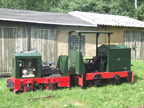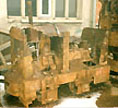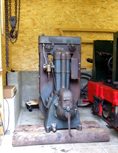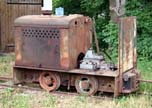 _
_ _
_ _
_ _
_ _
_ _
_
December 2008
Now and then the work on the benzene locomotive
type L180 has to be continued, if I don't want to capitulate
in view of the entire scope. Thus "currently" (what
can mean quite a longer period) the repair of the engine stands
on the agenda. After several weeks ago the flywheels were dismounted
and stored surely, now it was possible to remove the automatic
controller and the crankshaft. The crank weighs approx. 90kg and
it is a challenge to remove it alone without assistance. But it's
possible to lift one end… Also the piston (33,4kg weight
inclusive connecting rod) let drive out itself - but only with
the help of a 10kg sledge hammer and some wooden chunks. Aside
from the piston head he (nearly) looks like a new one. The next
to do is to pull out the cylinder sleeve, but it moved already
a little bit. A strange part at the automatic controller shaft
shaped up as a small oil pump, which was completely seized up.
Some affection led to the fact that it functioned completely again
and in future it can supply the piston with the necessary lubricating
oil. By the way the beer bottle in the pictures serves only for
size comparison and it's the item, which is fastest at hand in
the workshop : -) _
_ _
_ _
_ _
_ _
_ _
_
October 2008
At the beginning of the month at the "Historische
Feldbahn Dresden" near Pirna a show of locomotives produced
by O&K Montania took place. The cause for that presentation
was the 100th anniversary of the building of the first internal
combustion locomotive by this manufacturer in Nordhausen. It was
the rare opportunity to see 8 different "Montania" types
in action. The meeting was supported by guest locomotives. So
the RL1a No. 6281, the RL1c No. 10529 and the RL3 No. 20787
had the possibity to cruise on the rails in the "Herrenleite".
The RL3 was clearly the public favourite, but it made big problems.
The seals at the injection nozzles resisted the injection pressure
only for a few minutes. The solution was to drill (during the
reconstruction forgotten) holes for the leaking fuel.  _
_ _
_
In time to the 18th International Decauville
Railroad Meeting in Ramsen
the reconstruction of the Norwegian bicycle handcar has
been finished, firstly with 600mm gauge. However a problem of
the track in Ramsen were the differently heavy rails resp. broad
railheads. The bicycle suits for a head width of 40mm, which corresponds
with S18-rails usual at Decauville railroads. Only one-third of
the railway line in Ramsen has fitting rails for the handcar and
it was a problem to bring it over the rest of the distance. One
of the results was a broken part of the handlebar. But the locomotive
builder Bernd Bormann of Ramsen could repair it over night!
August 2008
The restoration of the RL1c No.
10529 is nearly finished. The engine starts without any problems
and runs perfectly. The size difference between RL1c and MD1 is
considerable.
July 2008
The reconstruction of the MD1 approaches
to their end after over 13 years. In order to check the correct
function of the loco, it has been taken place a " roll out"
and a test run on almost the entire 50m track in the garden. Also
the existing switch has been passed for several times! The result
was fairly satisfying, the engine runs very evenly, transmissions
and brake work faultless. An acoustic impression is possible by
clicking here. In the third picture
it is good to recognize, that a part of the side wall of the barn
can be folded away to make it possible to drive past. Now the
next step is the transport of the loco to Glossen, where it will
run for longer distances. At the end for camparison a picture
of the loco in "delivery condition". _
_ _
_ _
_ _
_
The search for many years for an adequate change engine
for the type M was finally crowned with success: a 8H.P.-petrol
motor of the Conord type F3 will supply the necessary traction
power to the locomotive in the future. It is not so haevy constructed
like the original implemented O&K-aggregate, but the 50cm
fly wheel will provide an equivalent energy storage combined with
a half H.P. more. The engine starts problem-free and runs with
the fuel, which was still in the tank. It could be 30 years old
according to statement of the salesman. _
_
June 2008
Because the OME117 was a spare
part source in the company it was coming from, some parts have
been dismounted, the gearbox included. Fortunately a fitting gearbox
was found in a workshop container nearby the loco. It could be
picked up. After years of separated storage now there was the
opportunity to mount it. At first the original and the rebuilt
spring of the rear axle were applied. The comprehensive reconstruction
of the OME117 has to wait because of more urgent projects.  _
_ _
_ _
_ _
_
Mai 2008
If somebody goes on a journey ... he can
tell about something but he can bring along something too. During
my trip to Norway I found an old railway bicycle, a so called
"Draisine", in a scrap heap of a nearly abandoned railway
station. The third wheel was missing but the Draisine was good
enough for reconstruction. That's why I devided the metal from
the wooden parts and took the steel components to Germany. The
security officers in the Oslo port agreed to bring the stuff abroad.
A friendly carpenter built a new wooden frame of larch and I bought
the Norwegian national colour red-brown for the wheels. I will
rebuilt the Draisine for 600mm but with the option of standard
gauge to run closed railway lines... _
_ _
_
April 2008
There are news from the MD2, changed
with the benzene loco in 2005: in their new home Norway the very
ambitious friends of the museum association in Stord
not only rebuilt the Mine railway track system during the last
years.They also made the old machinery house of the mine suitable
for their use and installed a complete old, small water power
station for museum purpose. The next step is to prepare the mine
for future visitors. Therefor they have to open the abandoned
tunnels to public. During a visit at the beginning of April we
could see and appreciate the successful activities of the norwegian
friends. During the last days it was possible to run the old tracks
in the mine by the MD2 first time since about 50 years.